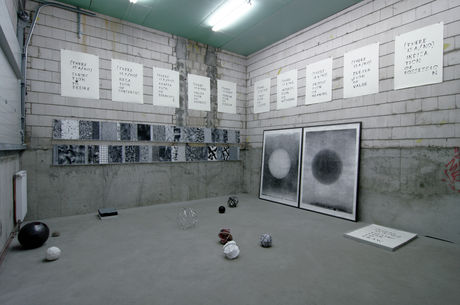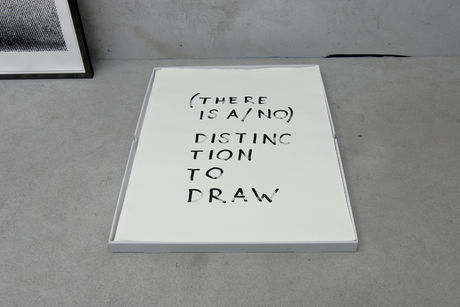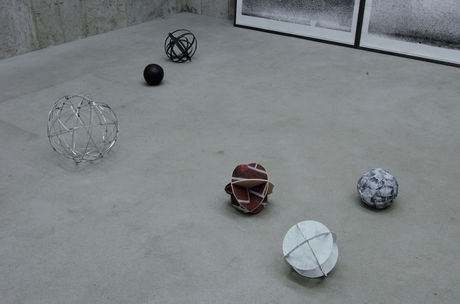KOW ISSUE 4
The Social Use of Signs (Obligation to Express)
Tina Schulz, Apr 3 - 27, 2009
To understand something means applying the signs of representation in such a way that proves useful in a societal environment. In fact, signs never stand for themselves. They only become meaningful when being used and utilized. No gesture, no word, no object around us has an inherent meaning, somewhere deep engraved, which we could ‘figure out’ if we only look close enough. Instead, the meaning of each sign is a social agreement. It is an approval of how certain statements are positioned in a social order.
And what if we deny approving? What do we understand then? If cognition is nothing more than using and renewing sedimented habits of representing reality (which also implies that we bear the social preconditions and consequences that come with it) – what image of reality and what kind of community remain, when we cannot or refuse to endorse these habits? How much leeway remains for the subject of cognition?
Now, an epistemological problem becomes political. Cognition is not merely the brain processing signs, but an interaction with other people – hence prone to conflict. As those, who care for meaning, we partake in the societal game of using signs, thereby co-deciding what means what. Already by perceiving things that way or that way, we are inescapably involved in the normative production of meaning rendering the significance of social reality. To understand something means to take a position in society. Cognition is the inevitable expression of a subject in a community.
There is no position on the outside. ‘Obligation to Express’, Tina Schulz’s correspondent series of text images is the point of departure for KOW ISSUE 4. Schulz complements the phrasing “There is a/no” with key notions of different theoretical discourses about normative statements: “There is a/no distinctino to draw“, „derivation of value“, „affirmation of behaviour“, „obligation to express“. She mirrors to the subject of cognition its participation in the process of normative production of meaning – provides it however a moment to reflect in a situation when the decision yet undetermined.
Schulz’s exhibition appropriates theoretical, aesthetical, and scientific vocabulary, by simplest means. She lays out formulistic expressions – in language, image and material – as arrangements of signs as if they were playing cards. They allow for a model situation, how to make use of conventions of interpretation. Moved from a societal concretion to an alternative symbolic plane, their usefulness is, however, no longer evident. The representation has gaps.
Concept and production: Tina Schulz. Text and photos: Alexander Koch
Einen Sachverhalt zu verstehen heißt, die Zeichen seiner Darstellung so zu verwenden, dass sie sich in einer sozialen Umwelt nützlich zeigen. Tatsächlich stehen Zeichen nie für sich selbst. Sie sind erst sinnvoll, wo man sie braucht und gebraucht. Keine Geste, kein Wort, kein Ding, mit dem wir uns umgeben, trägt seine Bedeutung schon fest in sich, irgendwo tief eingegraben, so dass wir nur gut genug hinschauen müssten, um sie ‚heraus zu finden‘. Stattdessen ist die Bedeutung jedes Zeichens eine soziale Übereinkunft. Eine Zustimmung dazu, wie bestimmte Aussagen im gesellschaftlichen Ganzen angeordnet sind.
Und wenn wir diese Zustimmung verweigern? Was ‚verstehen‘ wir dann eigentlich? Wenn Erkenntnis nichts anderes ist als die Verwendung und Erneuerung eingeschliffener Darstellungsgewohnheiten der Wirklichkeit (und dabei auch bedeutet, die sozialen Voraussetzungen und Konsequenzen dieser Gewohnheiten mit zu tragen) – welches Bild der Wirklichkeit und welche Gemeinschaft bleiben uns eigentlich, wenn wir diesen Gewohnheiten nicht beipflichten können oder wollen? Welcher Spielraum bleibt dem Subjekt der Erkenntnis?
Hier wird ein epistemologisches Problem politisch. Kognition ist eben nicht nur das Verarbeiten von Zeichen durch Rechenleistung des Gehirns, sondern Interaktion mit anderen Menschen – und daher konfliktreich. Als diejenigen, denen Sinn etwas gilt, sind wir Mitspieler beim gesellschaftlichen Gebrauch der Zeichen und entscheiden mit, was was ist. Allein dadurch, dass wir etwas so oder anders sehen, sind wir unweigerlich an der normativen Bedeutungsproduktion sozialer Wirklichkeit beteiligt. Etwas zu verstehen heißt, sich gesellschaftlich zu positionieren. Erkenntnis ist unhintergehbarer Ausdruck des Subjekts in Gemeinschaft.
Eine Position außerhalb gibt es nicht. ‚Obligation to Express‘, Tina Schulz gleichnamige Reihe von Schriftbildern, ist der Ausgangspunkt für KOW ISSUE 4. Die Satzformel „There is a/ no“ setzt Schulz mit Schlüsselbegriffen verschiedener Theoriediskurse zu normativen Aussagen fort: „There is a/ no distinction to draw“, „derivation of value“, „affirmation of behaviour“, „obligation to express“. Schulz spiegelt hier dem Subjekt der Erkenntnis seine Teilhabe am Prozess normativer Bedeutungsproduktion – verschafft ihm aber eine reflexive Verschnaufpause in einem Moment der Unbestimmtheit zwischen zwei möglichen Entscheidungen.
Die Ausstellung eignet sich theoretische, ästhetische und wissenschaftliche Vokabulare mit einfachsten Mitteln an. Schulz legt formelhafte Aussagen in Sprache, Bild und Material als Anordnungen von Zeichen wie Spielkarten aus. Diese erlauben einen modellhaften Gebrauch erlernter Deutungskonventionen, deren Tauglichkeit jedoch hier, aus der gesellschaftlichen Konkretion auf eine alternative symbolische Ebene verschoben, nicht mehr so klar ist. Die Repräsentation hat Lücken.
Konzept und Produktion: Tina Schulz. Text und Fotos: Alexander Koch


